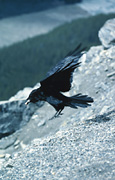Wednesday, March 09, 2005
A Modest Treatise on Ravens

photos.com
I have returned to the land of the raven.
These Blue Ridge Mountains are a special country, and a special bird makes its home here.
A half dozen ravens were in the back yard when I returned. They scooted as if they were late for something, but not before they’d polished off the last of the sunflower seed and cracked corn left for more common species – doves, juncos, chickadees -- 10 days previously.
Most flatlanders have never seen a raven. Or if, while visiting the mountain high country where the reclusive birds live, the visitors encountered a raven, they probably identified it as a crow on steroids.
The Audubon Nature Encyclopedia says a raven is "nearly twice as large as its relative, the common crow."
But that seems a bit much. I’d estimate a third to a half larger. I get to see them together, so my guess is as good as Audubon’s.
Few birds in history have generated as much legend, superstition, folklore – even fear -- as the raven. My take is that this elusive, shy bird has been much maligned.
In the Bible, ravens fed someone. I’ve forgotten who.
Poets have done a nasty job on the raven. Wrote Matthew Lewis:
"Three ravens sit in yonder glade
And evil will happen. I’m sore afraid
‘Ere we reach our journey’s end."
Edgar Allen Poe wrote a poem about a raven that had nothing better to do than sit and croak "Nevermore!" at him for half a night. Scared the poor man witless.
I heartily suspect Poe was smoking his socks at the time.
Ravens don’t really like human company that much, which may help explain our distrust. Any bird or animal that is not instinctively attracted to our sterling company is suspect. Right?
At any rate, when you visit the mountains, here’s how you can tell a raven from a crow.
The raven looks larger than any crow you ever saw.
When it isn’t fighting high winds, the raven has a neat and deeply forked -- or "v" shaped -- tail.
By comparison, a crow’s tail looks as if he’s having a bad-hair day.
Then there’s the beak.
A crow’s beak looks like…well, a large bird’s beak. Nothing unusual about it.
A raven’s beak, on the other hand, is thick and Romanesque. Picture a black Philip Roth with wings.
Ravens will begin mating soon in the mountains.
They’ll treat those of us who live here to some of the most spectacular aerial acrobatics in the bird world, wheeling and diving and pulling out of dives just before the pair crashes to earth.
Would that (in the words of the Bible) I could "…go and do likewise."
END
Comments:
<< Home
I was a pretty good wheeler and crasher in my time.
My problem was, I never learned to pull out of the dive in time.
Post a Comment
My problem was, I never learned to pull out of the dive in time.
<< Home

